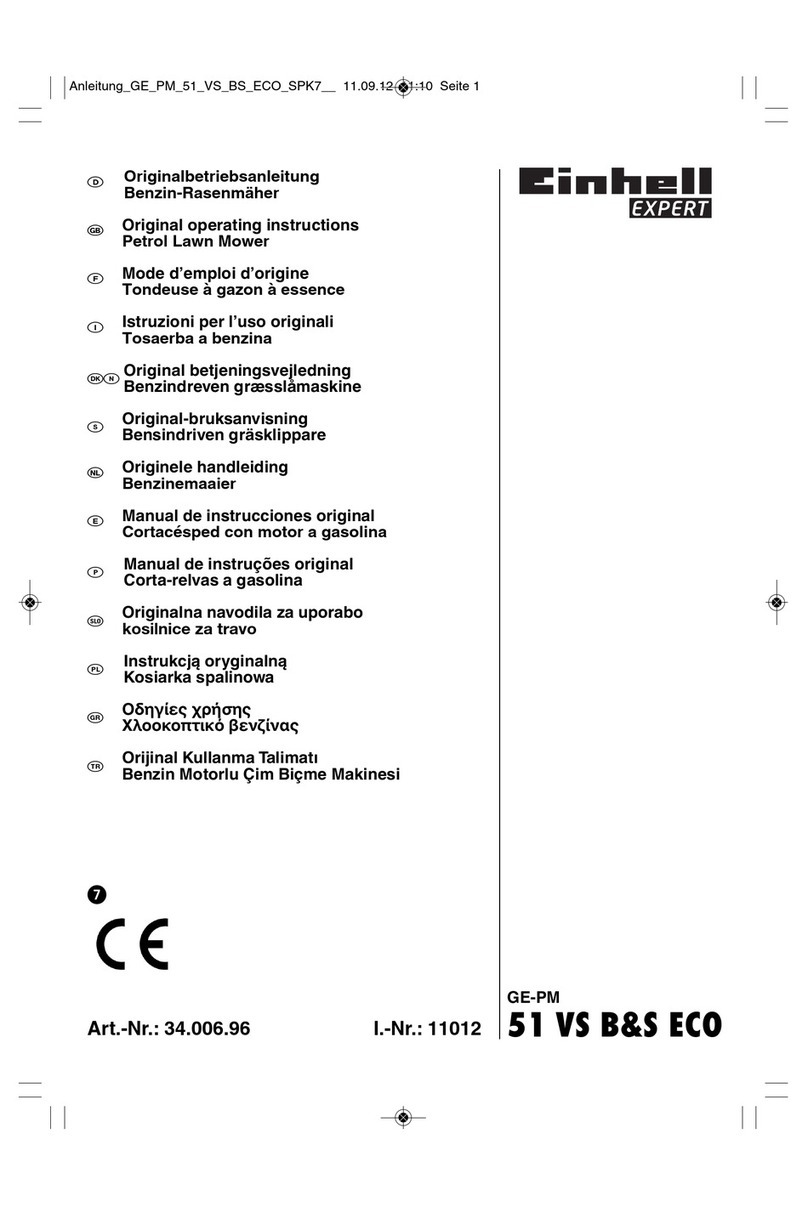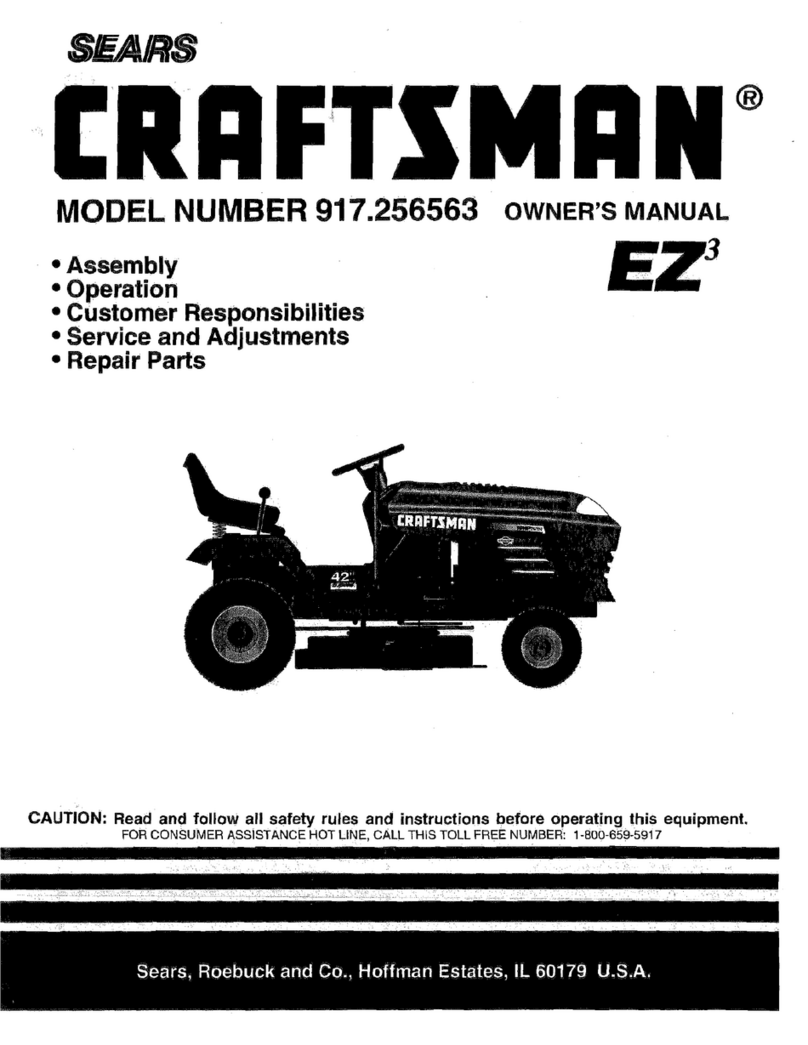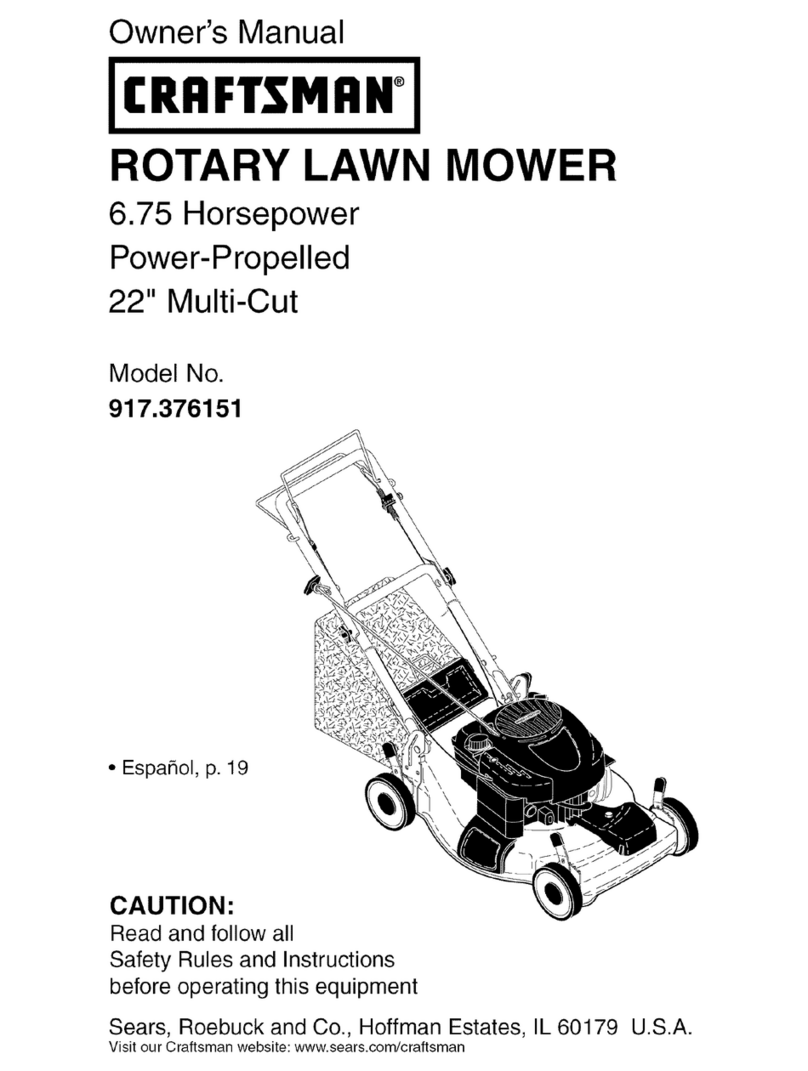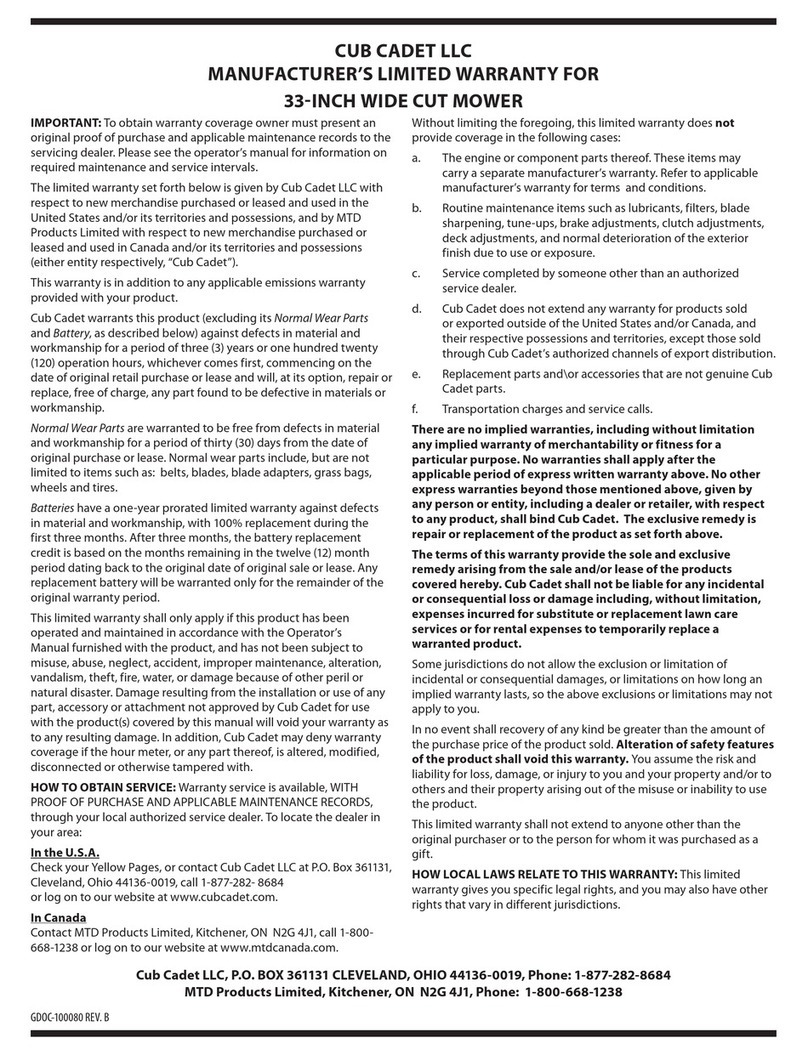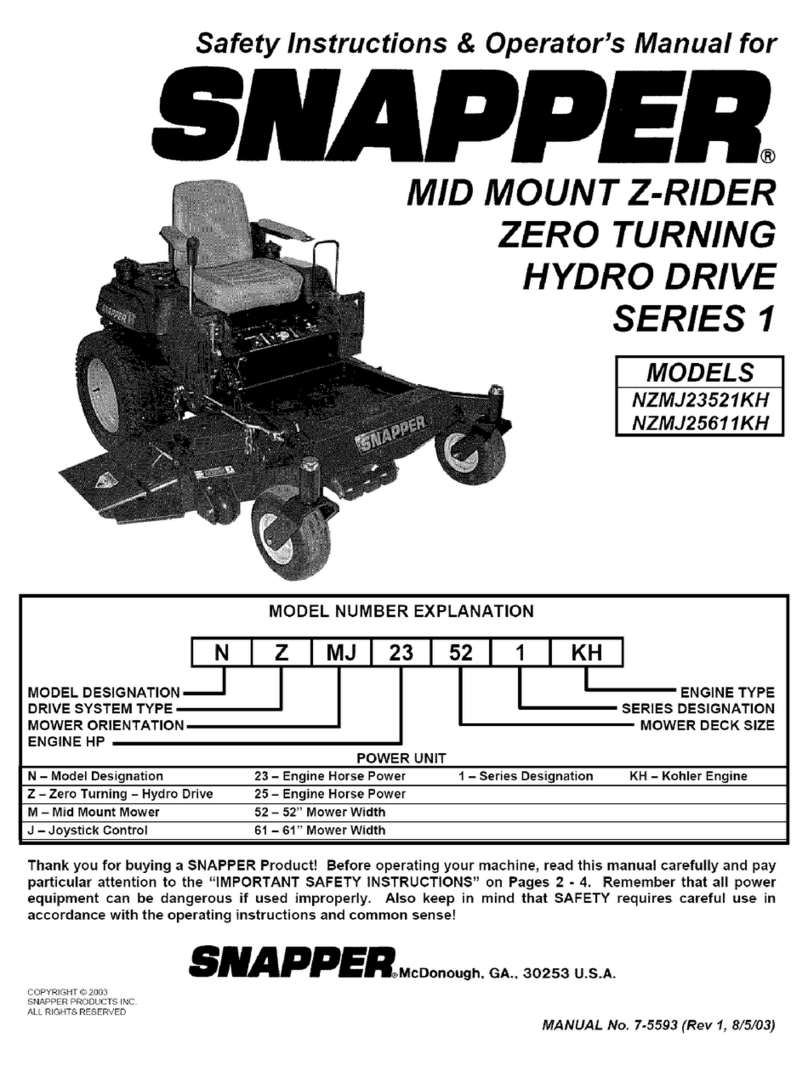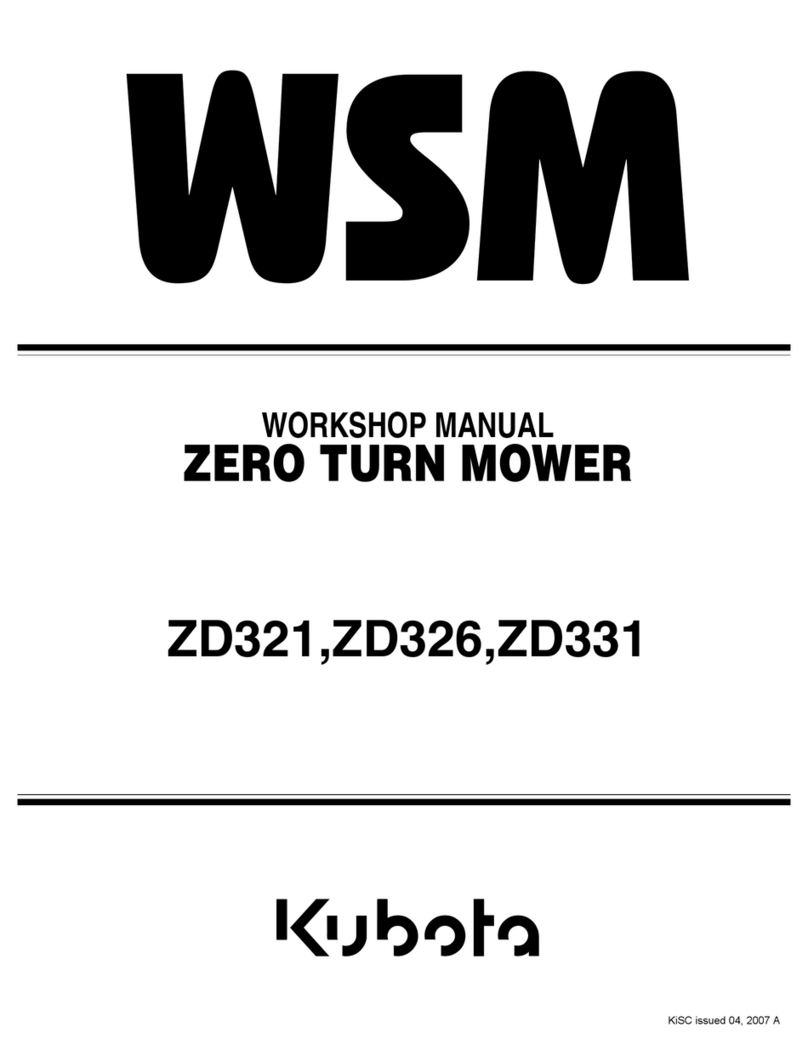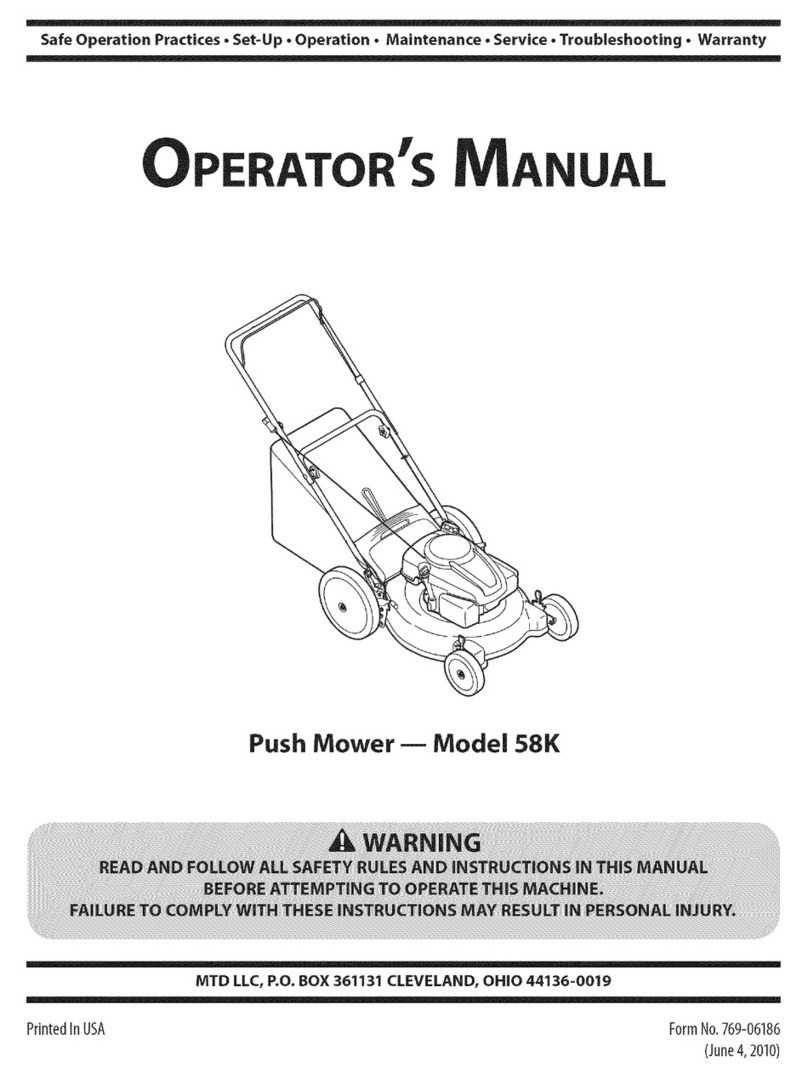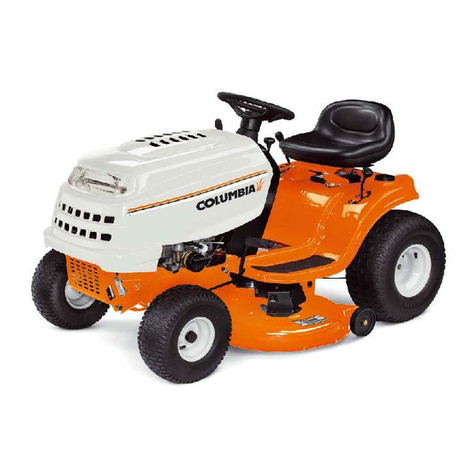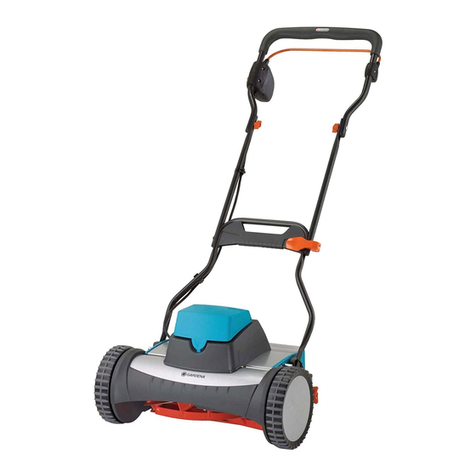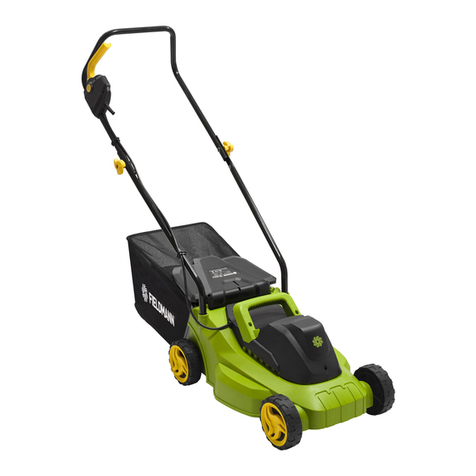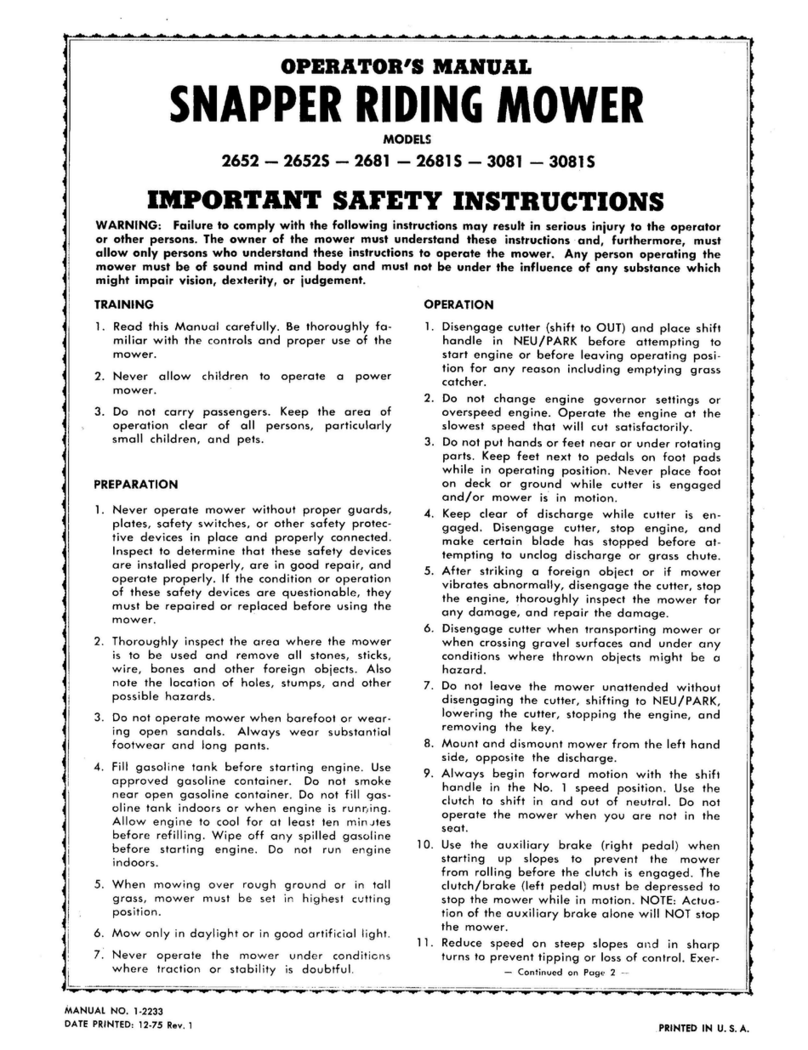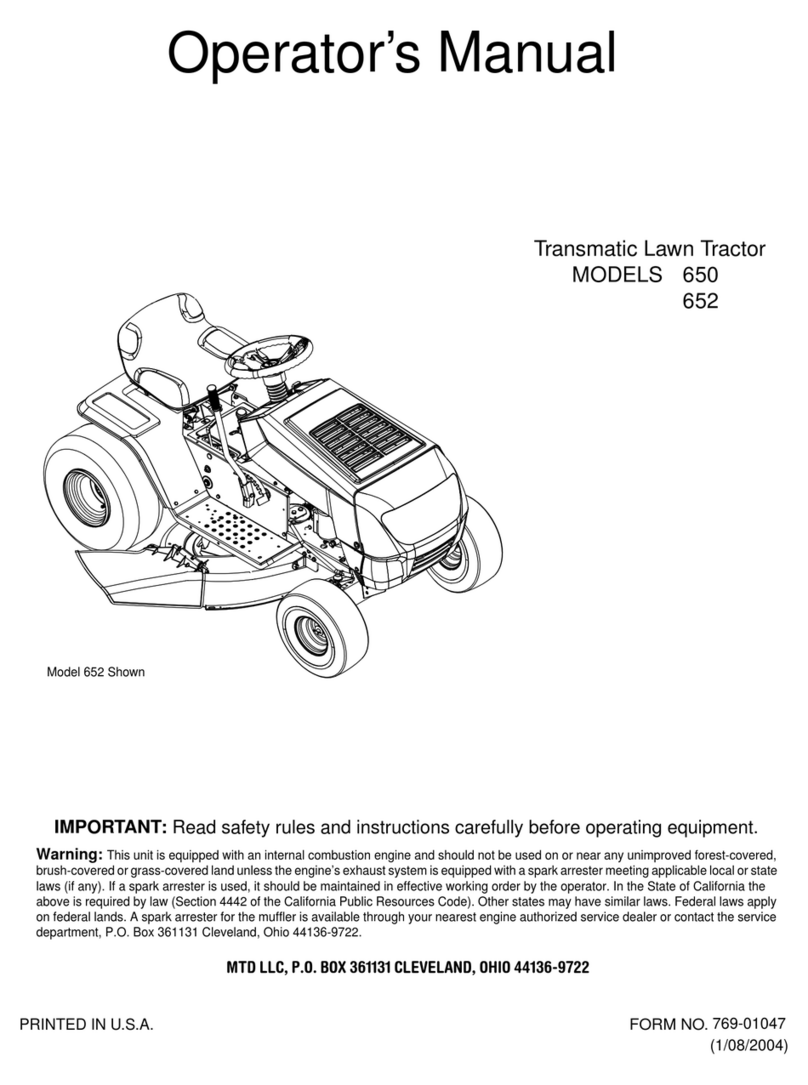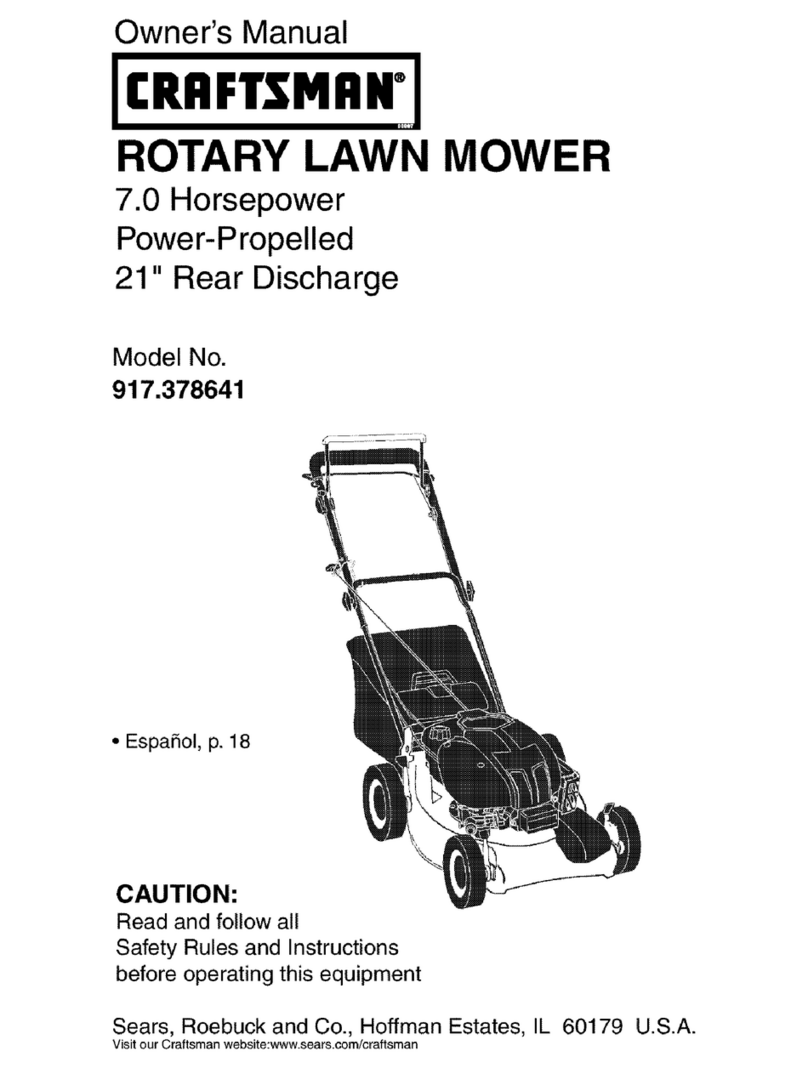EINHELL Expert GE-TM 102 B&S User manual

GE-TM 102 B&S
21011:.rN-.I12.600.43:.rN-.trA
7
GB
Original operating instructions
Ride - On Mower
Anl_GE_TM_102_BS_SPK7.indb 1 02.08.12 10:20

- 2 -
8
21 345
67
9
Anl_GE_TM_102_BS_SPK7.indb 2Anl_GE_TM_102_BS_SPK7.indb 2 02.08.12 10:2002.08.12 10:20

GB
- ʺ-
Handling
1. Do not let the combustion engine run in enc-
losed areas, as dangerous carbon monoxide
gas can build up.
2. Only mow in broad daylight or in well-lit con-
ditions. If possible, avoid using the equipment
on wet grass.
3. Disengage the auxiliary drive unit and set the
drive lever to the neutral position before you
start the mower.
4. Do not use the equipment on slopes with a
gradient of over 10°.
5. Remember that there is no such thing as a
“safe slope”. Driving on grassy slopes requi-
res particular concentration.To protect your-
self against overturning you should:
- Not stop or start offsuddenly when you are
driving up or down a slope.
- Engage slowly, leave the engine engaged,
especially when driving downslope.
- Keep to a low speed on slopes and on tight
turns.
- Watch out carefully for mounds, hollows and
other unseen dangers.
- Never mow across the slope unless the
machine construction is designed for the
purpose.
6. Be careful when you tow any loads or if you
use any heavy equipment. Only use approved
tow hitches.
7. Only attach loads that you know you can con-
trol.
8. Do not attempt to drive tight turns. Exercise
caution when reversing.
9. Pay special attention to car traffic if you cross
a street or if you are mowing close by one.
10. Stop the knife before crossing over any areas
other than grass.
11. If you use any attachments, make sure that
this does not cause grass to be thrown in the
direction of people and that no persons are
nearby.
12. Never use machines if protective equipment
is damaged or not fitted.
13. Do not adjust or overclock the motor speed
settings. Operating the equipment at excessi-
ve speed may increase the risk of accidents.
14. Before you leave the driver’s seat:
- Disengage the drive unit for the attachment
and lower it.
- Engage idle mode and apply the locking
brake.
- Switch offthe engine and pull out the igniti-
on key.
15. Disengage the drive unit for the attachments,
switch offthe engine and pull out the spark
boot plug and the ignition key:
- Before you dislodge any blockages or clogs
in the chute.
- Before carrying out any checks, cleaning or
other work on the machine.
- If you have struck a foreign object. Examine
the machine for signs of damage and carry
out any necessary repairs before restarting
and continuing to work with the machine.
- If the machine begins to experience excepti-
onally strong vibrations, immediately check it.
16. Disengage the drive units for attachments
whenever you intend to transport the mower
or not use it for any length of time.
17. Switch offthe engine and disengage the drive
unit for the attachments:
- Before you refuel.
- Before you remove any grass catching de-
vices.
- Before you change the height setting if this
cannot be done from the user’s position.
18. Close the engine‘s throttle valve when the
machine has run down.When you have fi-
nished mowing with the machine, close the
petrol stopcock if it has one.
Maintenance and storage
1. Make sure that all nuts, bolts and screws are
tightened securely and that the machine is in
safe working condition.
2. Never store the mower (with petrol in the
tank) inside a building in which petrol fumes
could come into contact with open flames or
sparks.
3. Allow the engine to cool before you put the
lawn mower in an enclosed area.
4. In order to avoid fire hazards, keep the engi-
ne, exhaust and the area around the fuel tank
free from grass, leaves and leaking grease
(oil).
5. Routinely check the grass basket for signs of
wear and impaired functionality.
6. For your own safety, replace worn or dama-
ged parts without delay.
7. If the fuel tank needs to be emptied, ensure
that it is done out in the open with a petrol
suction pump (available from DIY stores).
8. Carry out adjustment work on the equipment
with care and avoid jamming your fingers bet-
ween the moving blades and rigid parts of the
equipment.
9. Please note that the rotation of one of the bla-
des can cause the other one to rotate as well.
Anl_GE_TM_102_BS_SPK7.indb 20Anl_GE_TM_102_BS_SPK7.indb 20 02.08.12 10:2002.08.12 10:20

GB
- ʻ-
10. Lower the mower unit when you park the mo-
wer or put it into long-term storage.
1.2 Safety information for the charger
• Wear safety goggles and gloves when char-
ging the battery.The caustic acid presents a
high risk of injury.
• Do not wear any items of clothing made
of synthetic materials so as to avoid spark
formation caused by electrostatic discharge
when charging the battery.
• CAUTION! Avoid explosive gases, flames and
sparks.
• The charger contains components such as
the switch and fuses which may generate
arcs and sparks. It is essential to ensure that
there is good ventilation in the garage or
room.
• The charger is suitable for maintenance-free
12V batteries only.
• Do not charge any “non-rechargeable batte-
ries” or defective batteries.
• Refer to the instructions supplied by the bat-
tery manufacturer.
• Disconnect the equipment from the mains
supply before you connect or disconnect the
battery.
• Important. Avoid flames and sparks.
• Explosive gas is released during the charging
process.
• Store the equipment in a dry indoor location
only.
• Caution! Battery acid is aggressive.
• Should any acid splash onto hands or
clothing, wash off immediately with soap so-
lution. Should any acid splash into your eyes,
wash it out immediately with water (for 15 mi-
nutes) and seek the advice of a doctor.
• Do not charge any non-rechargeable batte-
ries.
• Refer to the information and instructions pro-
vided by the battery manufacturer relating to
charging the battery.
• Do not charge more than one battery at any
one time.
• The mains connection lead and the charging
cables must be in perfect condition.
• Keep children away from the battery and
charger.
• Important. If you smell an acrid odor of gas,
this indicates that there is an acute danger of
explosion. Do not switch off the equipment.
Do not disconnect the battery from the power
supply! Ventilate the room immediately. Have
the battery checked by customer service staff.
• Do not use the cable for purposes other than
that for which it is designed.
• Do not carry the charger by its cable and do
not use the cable to pull the plug out of the
socket. Protect the cable from heat, oil and
sharp edges.
• Check the equipment for damage.
• Unless otherwise stated in the operating inst-
ructions, defective or damaged parts must be
repaired or replaced by a customer service
workshop.
• Only ever use the supply voltage specified.
• Keep the connectors clean and protect them
from corrosion.
• Disconnect the equipment from the mains
supply before starting any cleaning or mainte-
nance work.
• Wear acid-resistant gloves and safety gogg-
les when connecting and charging the battery.
• Important. Do not exceed the charging time.
After the end of the charging time pull the
plug out of the socket and disconnect the
charger from the battery.
1.3 Safety precautions for batteries
1. Make sure at all times that the batteries are
fitted with the + and – terminals on the bat-
teries correctly positioned as shown on the
battery.
2. Do not short-circuit the batteries.
3. Do not recharge non-rechargeable batteries.
4. Do not exhaust the battery charge.
5. Do not heat batteries.
6. Do not do any welding or soldering directly on
batteries.
7. Do not disassemble batteries.
8. Do not deform batteries.
9. Do not throw batteries into a fire.
10. Keep batteries out of the reach of children.
11. Do not allow children to change batteries wit-
hout supervision.
12. Do not store batteries near fire, stoves or
other sources of heat. Do not expose the bat-
tery to direct sunlight. Do not use or store it in
vehicles in hot weather.
13. Keep unused batteries away from metallic
objects.This could cause the battery to short-
circuit and may therefore cause damage to
the battery, burns and even the risk of fire.
14. Take the batteries out of the equipment if the
equipment is not going to be used for some
time.
15. NEVER touch batteries which have leaked
unless you have taken suitable precautions
for protection. If the fluid which has leaked
Anl_GE_TM_102_BS_SPK7.indb 21Anl_GE_TM_102_BS_SPK7.indb 21 02.08.12 10:2002.08.12 10:20

GB
- ʼ-
should come into contact with your skin, rinse
down the affected area of skin immediately
with running water. Make sure in any event
that your eyes and mouth do not come into
contact with the fluid. If this should happen,
consult a doctor immediately.
16. Clean the contacts on both the batteries and
the equipment before inserting the batteries.
This equipment is not designed to be used by
people (including children) with limited phy-
sical, sensory or mental capacities or those
with no experience and/or knowledge unless
they are supervised by a person who is res-
ponsible for their safety or they have received
instructions from such a person in to how
to use the equipment safely. Children must
always be supervised in order to ensure that
they do not play with the equipment.
Waste disposal
Batteries: Only dispose of these items through
motor vehicle workshops, special collection
points or special waste collection points. Ask your
local council.
1.4 Explanation of the warning signs on the
equipment (see Fig. 2)
1) Read the operating instructions
2) Important. Danger from catapulted parts. Ne-
ver use machines if protective equipment is
damaged or not fitted. Important. Danger from
catapulted parts. Keep a safe distance.
3) Be careful of the sharp cutters. Switch offthe
engine and pull the spark plug boot before
doing any maintenance, repair, cleaning or
adjustment work.
4) Fill with oil and fuel before starting.
5) Caution! Wear ear protection and safety gog-
gles.
6) Risk of cut injuries. Caution: rotating cutters.
Never use the mower unit as a step.
7) Important. Switch offthe engine for refueling.
8) Accelerator pedal (forward)
9) Accelerator pedal (reverse)
2. Layout and items supplied
Figures 1-57 can be found in the separate booklet
“Product illustrations for the Original Operating
Instructions”
2.1 Layout (Fig. 1-57)
1. Grass basket
2. Release lever for grass basket
3. Cutting height adjustor lever
4. Seat
5. Steering wheel
6. Accelerator pedal (reverse)
7. Accelerator pedal (forward)
8. Headlights
9. Front wheel
10. Mower unit
11. Rear wheel
12. Locking brake
13. Brake pedal
14. Throttle lever
15. Light switch
16. On/Offswitch for the mower unit
17. Ignition lock
18. Ejector chute
19. Release lever for gears
20. Bar
21. 8-10mm open-ended wrench
22. 13-15 mm open-ended wrench
23. 10-12mm multi-functional wrench
24. 13-19 mm multi-functional wrench
25. 5 mm Allen key
26. Philips screwdriver
27. 2x ignition keys
28. Screw (cross recessed head)
29. Nut
30. Washer
31. Screw (internal hexagon)
32. Fuse (10 amps)
33. Petrol tank / filling cap
34. Viewing window for fuel level
35. 2x cleaning connection
36. Trailer hitch
37. Battery
38. Blade, right
39. Blade, left
40. Handle
41. Oil filter
42. Oil filling cap
43. Oil drainage screw
Anl_GE_TM_102_BS_SPK7.indb 22Anl_GE_TM_102_BS_SPK7.indb 22 02.08.12 10:2102.08.12 10:21

GB
- ʽ-
2.2 Items supplied
Please check that the article is complete as spe-
cified in the scope of delivery. If parts are missing,
please contact our service center or the nearest
branch of the DIY store where you made your
purchase at the latest within 5 work days after
purchasing the article and upon presentation of
a valid bill of purchase. Also, refer to the warranty
table in the warranty provisions at the end of the
operating instructions.
• Open the packaging and take out the equip-
ment with care.
• Remove the packaging material and any
packaging and/or transportation braces (if
present).
• Check to see if all the items are supplied.
• Inspect the equipment and accessories for
transport damage.
• If possible, keep the packaging until the end
of the guarantee period.
Important.
The equipment and packaging material are
not toys. Do not let children play with plastic
bags, foils or small parts. There is a risk of
choking and suffocating!
Important:
To prevent damage, set the mower unit to
the highest level when you unload the mo-
wer and push it slowly offthe transportation
pallet.
Note: Place boards between the struts of the
transportation pallet.
You have to disengage the gears to be able to
push the mower. To do so, push the release
lever (Item 19) inwards and hook into place
(Fig. 13). Only do this with the engine swit-
ched off. For driving, the release lever has to
be moved to the outer position (Fig. 12). Only
do this with the engine switched off.
• Lawn tractor
• Seat
• Steering wheel
• Grass basket
• Release lever for grass basket
• Bar
• 2x ignition keys
• Screw (cross recessed head)
• Battery
• Nut
• Washer
• Screw (internal hexagon)
• Original Operating Instructions
• Product illustrations for the Original Operating
Instructions
Tools:
• 8-10mm open-ended wrench
• 13-15 mm open-ended wrench
• 10-12mm multi-functional wrench
• 13-19 mm multi-functional wrench
• 5 mm Allen key
• Philips screwdriver
3. Intended use
The petrol lawn mower is suitable for use in public
facilities, parks and sports centers, on farms or in
the forestry sector. The lawn mower is designed
to be used for maintaining grassed or turfed sur-
faces.
The operating instructions as supplied by the ma-
nufacturer must be kept and referred to in order
to ensure that the lawn mower is properly used
and maintained.The instructions contain valuable
information on operating, maintenance and servi-
cing conditions.
Important. Due to the high risk of bodily injury to
the user, the petrol lawn mower must not be used
to carry out the following work:To cut scaling ve-
getation, planted roofs, or balcony-grown grass,
to clean (suck up) dirt and debris offwalkways, or
to chop up tree or hedge clippings. Moreover, the
lawn mower may not be used as a power cultiva-
tor to level out high areas such as molehills.
The equipment may be used only for its intended
purpose. Any other use is deemed to be a case of
misuse.The user/operator and not the manufactu-
rer will be liable for any damage or injuries of any
kind resulting from such misuse.
Anl_GE_TM_102_BS_SPK7.indb 23Anl_GE_TM_102_BS_SPK7.indb 23 02.08.12 10:2102.08.12 10:21

GB
- ʾ-
4. Technical data
Note:
The enclosed manual from Briggs & Stratton pro-
vides detailed technical data on the engine!
Engine type: ...... One-cylinder four-stroke engine
Power: ............... 12.8 kW (17.4 hp) at 2800 min-1
Fuel: .......................................................... Petrol
Cutting height adjustment: .. Central, (30-90 mm)
Cutting width: ...................................... 1,020 mm
Blade length: .......................................... 518 mm
Weight: ......................................................220 kg
Tire size, front: ....................................15 x 6.00-6
Tire size, rear: ....................................18 x 8.50-8
Air pressure of tires, front: ....................... 1.0 bar
Air pressure of tires, rear: ........................ 0.8 bar
Max. velocity, forward: ............. Infinite 0 - 8.8 kph
Max. velocity, reverse: ................ Infinite 0 - 5 kph
Towing capacity: ........................................300 kg
Vertical load: ...............................................75 kg
Battery: ............................................. 12 V 18 Ah
Sound and vibration
LpA sound pressure level .................... 86.9 dB(A)
KpA uncertainty .............................................3 dB
LWA sound power level ........................ 100 dB(A)
KWA uncertainty .............................................3 dB
Wear ear-muffs.
The impact of noise can cause damage to hea-
ring.
Total vibration values (vector sum of three direc-
tions) determined in accordance with EN 836.
Vibration emission value ah = 10.97 m/s2
K uncertainty = 1.5 m/s2
5. Before starting the equipment
Assembling the components
Some parts of the mower come disassembled.
The work of assembly should be carried out by 2
people. For quick and easy assembly, read and
follow the instructions below.
Important. You will need the following additional
tools (not supplied) for assembly, and also for
maintenance work:
• A flat oil drip tray (for changing the oil)
• A 1 liter measuring jug (oil/petrol resistant)
• A petrol can
• A funnel (suitable for the tank’s petrol filler
neck)
• Household wipes (to wipe up oil/petrol resi-
due; dispose of these at a filling station)
• A petrol suction pump (plastic, available from
DIY stores)
• An oil can with hand pump (available from
DIY stores)
Fitting the steering wheel (Fig. 9 - 11)
Place the machine on a straight and level surface.
Align the wheels straight ahead and fit the stee-
ring wheel (Item 5) as shown.
Inserting and removing the battery
(Fig. 14-15)
Important. Use the mower only with a mainte-
nance-free 12V battery.
Place the battery (Item 37) on the base. First con-
nect the red cable “+” and then the black cable “-”.
Secure the battery with the tensioning spring (Fig.
15). Remove it in reverse order.
Important. Do not disconnect the battery from
the electrical system during operation as this may
destroy the charge electronics.
Charging the battery from the electrical sys-
tem
The battery is charged by the generator via the
electrical system during operation.
Charging the battery with the charger
If the battery has lost its charge, it can be charged
up with a charger (not included in delivery) via the
household mains system. Disconnect the battery
from the electrical system as described in the
section: “Inserting and removing the battery”. We
recommend that you use an Einhell charger.
Anl_GE_TM_102_BS_SPK7.indb 24Anl_GE_TM_102_BS_SPK7.indb 24 02.08.12 10:2102.08.12 10:21

GB
- ʿ-
Important. Explosive gas is generated during the
charging process.This could collect under the co-
ver if closed and lead to explosive ignition. When
you charge the battery, refer to the safety regulati-
ons supplied by the battery manufacturer.
Important. Explosive gas can be generated du-
ring the charging process.You should therefore
avoid spark formation and naked flames during
the charging process.
Fitting the driver’s seat (Fig. 16)
Fit the seat (Item 4) as shown. Adjust the position
of the seat by moving it in the slots. Adjust it to a
comfortable sitting position and make sure that
you can reach all of the control levers and pedals
easily.
Grass basket assembly (Fig. 17-24)
• Fig. 17: Spread the grass basket out in front
of you. Fit the handle (Item 40).
• Fig. 18: Fasten the bar (Item 20) to the bottom
part of the grass basket with the screws (Item
28), nuts (Item 29) and washers (Item 30).
• Fig. 19: Swing the top part of the grass basket
up.
• Fig. 20: Fasten the top part of the grass bas-
ket to the bar (Item 20) with the screws (Item
28), nuts (Item 29) and washers (Item 30).
• Fig. 21-22: Fit the two support struts (Item a).
Use the screws (Item c) and nuts (Item b) to
do so.
• Click the plastic rail (Item k) into the bar.
• Fig. 23: Push the release lever for the grass
basket (Item 2) into the assembly opening on
the grass basket and secure it with the screw
(Item 28) and nut (Item 29) to prevent it from
working its way out.
Important.
Ensure that all screws are secure.
• Fig. 24: Fully assembled grass basket.
Fitting the grass basket to the tractor lawn
mower (Fig. 25-29)
• Fig. 25-26: Attach the grass basket to the at-
tachment points (Item e).
• Fig. 27: Note that the marking arrows are op-
posite each other.
• Fig. 28: Before you can close the grass bas-
ket you have to open it fully so that it latches
completely into the attachment points.
• Fig. 29: Lock the grass basket by exerting
slight pressure on the rear handle.
6. Operation
Note:
For detailed information on starting the engine, re-
fer to the enclosed manual from Briggs & Stratton.
Important.
The engine does not come with oil in it.Therefore,
be sure to add oil before starting the engine for
the first time.You will also need to fill in petrol, as
this is also not supplied upon delivery.
Whenever you need to perform any adjustment
and/or repair work on your lawn mower, wait until
the blade has come to a complete stop. Always
switch offthe engine before carrying out any ad-
justments, maintenance or repairs.
Warning: Never use more than one safety petrol
can. Do not smoke when refueling. Switch offthe
engine before refueling and allow the engine to
cool down for a few minutes.
Safety switch
To prevent injuries from improper use, the lawn
mower is equipped with various safety devices.
To be able to start the engine, the following condi-
tions must be met:
• Gear position →neutral
• The mower unit must be switched off.
• The operator must be sat on the seat.
• The locking brake must be applied.
The engine cuts automatically whenever the ope-
rator leaves the seat.
Each time before use, check the tire pressure
and oil level.
Speed lever (Fig. 30)
Move the throttle lever (Item 14) in order to incre-
ase or decrease the engine speed. For optimum
mowing results we recommend that the throttle
lever should be set to the “Hare” position.
Tortoise = Slow
Hare = Fast
“ ” = Choke (enables a quick cold start)
Lights (Fig. 30):
Vehicle lights ON/OFF (Item 15).
Note: The lights only work if the ignition lock is in
the “ON” position.
Anl_GE_TM_102_BS_SPK7.indb 25Anl_GE_TM_102_BS_SPK7.indb 25 02.08.12 10:2102.08.12 10:21

GB
- ˀ-
Mower unit switch (Fig. 31)
Use the ON/OFF switch for the mower unit (Item
16) to start the mower unit.
“I” = On
“O”= Off
Pay attention to the safety instructions.
Ignition lock (Fig. 31/Item 17)
Settings:
STOP= Turning offthe engine
ON=Turning on the ignition
START=Starting the engine
Changing the fuse (Fig. 32)
If the 10A fuse (Item 32) is defective, replace it as
illustrated.
Important.
A defective fuse is always the result of a fault in
the electrical system. A check should be carried
out by an authorized service center.
Cutting height adjustment (Fig. 33)
Use the cutting height adjuster lever (Item 3) to
adjust the cutting height. Actuate the lever as
illustrated.
Locking brake (Fig. 34-35)
To actuate the locking brake, press the brake pe-
dal (Item 13) down.To lock the brake pedal in the
brake position, press the locking brake (Item 12).
To release the locking brake, press briefly on the
brake pedal (Item 13).
Note: The engine can only be started if the lo-
cking brake is applied.
Accelerator pedal (Fig. 36-37)
The accelerator pedal (forward) (Item 7) and the
accelerator pedal (reverse) (Item 6) are for cont-
rolling the driving direction and speed.
Note: Release the locking brake first.
F →Forward
R →Reverse
The further you press the accelerator, the faster
the speed.
Note: Only change the driving direction (forward/
reverse) once the vehicle has come to a stop.
Note on driving: Set the switched offmower unit
to the highest level before setting off.
Replacing the light bulb (Fig. 50)
Open the engine hood.To change the light bulb
(18 W), twist the connector (Item m) counter-
clockwise.
6.1 Mowing
Only use a sharp blade that is in good condition.
This will prevent the grass blades from fraying
and the lawn from turning yellow.
Try to steer in straight lines for a nice, clean look.
The swaths should overlap each other by a few
centimeters in order to avoid stripes. For optimum
mowing results we would recommend that you
plan your path with left-hand turns only.
Keep the underside of the mower housing clean
and remove grass build-up. Deposits not only
make it more difficult to start the mower; they
decrease the quality of the cut and make it harder
for the equipment to bag the grass. Always mow
along inclines (not up and down).You can prevent
the lawn mower from slipping down by holding a
position at an angle upwards. Select the cutting
height according to the length of the grass. If ne-
cessary, mow a number of times so that you never
cut more than 4cm of grass in one go.
Switch offthe engine and pull out the ignition key
and spark boot plugs before doing any checks on
the blade. Keep in mind that the blade continues
to rotate for a few seconds after switching off. Ne-
ver attempt to manually stop the blade. Regularly
check to see if the blade is securely attached,
is in good condition and is sharp. If the contrary
is the case, have the blade sharpened or repla-
ced. In the event that the blade strikes an object,
immediately switch offthe lawn mower and wait
for the blade to come to a complete stop. Then
inspect the condition of the blade and the blade
mount. Replace any parts that are damaged.
Starting mowing
Important. Be sure to observe the safety ins-
tructions.
1. Start the engine. Important: Observe all the
information on operation contained in this ma-
nual.
Note: For detailed information on starting the
engine, refer to the enclosed manual from Briggs
& Stratton.
Important.
If you actuate the ignition key again while the
engine is running, you will damage the starting
system.
2. Place the speed lever in the “Hare” position.
3. Set the mower unit to the highest possible
position.
4. Start the mower unit.
Anl_GE_TM_102_BS_SPK7.indb 26Anl_GE_TM_102_BS_SPK7.indb 26 02.08.12 10:2102.08.12 10:21

GB
- ʸʷ -
5. Release the locking brake. Slowly actuate the
drive lever (forward). Adjust the cutting height
and driving speed to the grass you are going
to mow.
Note:
• For optimum mowing results with thick, high
grass, use a low speed.
• Switch off the mower unit whenever you re-
verse.
• Switch off the mower unit and set it to the
highest position before crossing over any
obstacles.
Level indicator for the grass basket
The grass basket is supplied with a sensor which
emits a signal tone to tell you when the grass bas-
ket is full. Switch offthe mower unit whenever the
signal sounds (Section 6 Mower unit switch). Do
not let the grass basket get too full as it will clog
the ejector chute.
6.2 Emptying the grass basket (Fig. 38)
Important. Never open the grass basket when
the mower unit is running.
1. Apply the locking brake.
2. Pull the release lever for the grass basket
(Item 2) up and out of the holder.
3. The grass basket can now be emptied with
ease.
4. Close the grass basket. Ensure that the grass
basket is fully closed again.
5. Slide the release lever back into the holder
again.
6. Resume mowing, having regard for the safety
instructions as you do so.
Cleaning the ejector chute
The ejector chute can become clogged if you
mow wet grass or if you drive too fast when mo-
wing (Fig. 25/Item 18). Please follow these inst-
ructions in order to remove a blockage:
1. Disengage the drive unit for the attachments,
apply the locking brake, switch offthe engine
and pull out the spark boot plug and the igniti-
on key.
2. Check that all moving parts have reached a
complete standstill.
3. Remove the grass basket.
4. Remove the blockage with a stick.
5. Move forward a short distance before swit-
ching on the mower unit again.
6.3 After mowing
1. Always allow the engine to cool before you
put the lawn mower in an enclosed area.
2. Remove grass, foliage, grease and oil before
storing the mower. Do not place any objects
on top of the mower.
3. Before using the mower again, retighten all
nuts and screws. Tighten all screws which
were slackened.
4. Also be sure to empty the grass basket.
5. Disconnect the spark plug boot to prevent
unauthorized use.
6. Ensure that you do not park the mower next
to any source of danger. Petrol fumes can
lead to explosions.
7. Only original parts or parts approved by the
manufacturer may be used for repairs
(see address on the warranty certificate).
8. Empty the petrol tank with a petrol extraction
pump if you are not intending to use the mo-
wer for an extended period of time.
9. Tell your children not to use the mower. It is
not a toy.
10. Never place petrol near an ignition source.
Always use a can that is approved to store
petrol. Keep petrol away from children.
11. Oil and maintain the equipment.
7. Cleaning, maintenance, storage,
transport and ordering of spare
parts
Important: The enclosed engine manual from
Briggs & Stratton provides maintenance informa-
tion and maintenance interval information on the
engine.
Important:
Never work on or touch any current-conducting
parts of the ignition system while the engine is
running. Pull the spark plug boot from the spark
boot before doing any maintenance or assembly
work. Never carry out any work on the equipment
while the engine is running. Work that is not de-
scribed in these operating instructions should
only be carried out by authorized workshops.
Anl_GE_TM_102_BS_SPK7.indb 27Anl_GE_TM_102_BS_SPK7.indb 27 02.08.12 10:2102.08.12 10:21

GB
- ʸʸ -
7.1 Cleaning
The lawn mower should be cleaned thoroughly
every time after it has been used.This particularly
applies to its underside and the blade mount.
It is easiest to remove dirt and grass immediately
after mowing. Dried grass remnants and dirt may
impair the mowing operation. Check if the grass
ejector chute is free of grass remnants and remo-
ve any if necessary. Never clean the engine using
a water jet or a high-pressure cleaner. The engine
must remain dry. Do not use aggressive cleaning
agents such as cold cleaners or petroleum ether.
In order to ensure that the majority of grass clip-
pings are picked up, the inside of both the grass
bag and especially the air grill must be cleaned
after each use.
Important. Do not use your hands or feet to re-
move clippings in or on the mower housing, but
instead use suitable tools such as a brush or a
hand broom.
Cleaning the mower unit (Fig. 41)
The mower unit is supplied with a hose connec-
tion on both sides (Item 35) (suitable for conventi-
onal garden hose couplings).
1. Place the mower on a firm surface.The grass
basket must be fitted.
2. Set the mower unit to the lowest position.
3. Connect the hose to the hose connection.
Turn on the water supply.
4. Move the drive lever to the neutral position
and start the engine; the operator must be sat
on the seat.
5. Engage the drive for the mower unit.
6. Clean each side in this way for 1-2 minutes
depending on the amount of dirt.
Important.
Switch offthe engine when you attach the hose to
the opposite side.
After you have switched offthe engine, remove
the grass basket and clean it. Wait until the mower
is dry before putting into long-term storage.
7.2 Maintenance
Important: The enclosed engine manual from
Briggs & Stratton provides maintenance informa-
tion and maintenance interval information on the
engine.
Dispose of soiled maintenance material and ope-
rating materials at the appropriate collection point.
7.2.1 Blades
For safety reasons, have all blade sharpening,
balancing and mounting work carried out by an
authorized service center. To achieve optimal re-
sults, we recommend to have the blades checked
once a year.
Changing the blades (Fig. 53-54)
When changing the cutting unit, be sure to use
only genuine replacement parts. Never install a
blade from a different manufacturer.
1. Fig. 53
Screw (Item 1a) for right blade (Item 38) →
undo in a clockwise direction
Screw (Item 1b) for left blade (Item 39) →
undo in a counterclockwise direction
2. When you replace the blades, remember that
because of the different directions of rotation,
2 different blades have to be fitted.To ensure
that you fit the correct blades on the correct
sides, refer to the numbers stamped on the
blades:
Blade, right (Item 38): 0606668
Blade, left (Item 39): 0606665
3. Fig. 54
When you fit the spring washer (Item 1c),
make sure that the curved side faces the
screw head.
4. Fig. 54
Screw (Item 1a) for right blade (Item 38) →
tighten in a clockwise direction.
Screw (Item 1b) for left blade (Item 39→tigh-
ten in a counterclockwise direction
Tightening torque: 40-45 Nm
Damaged blades
If, in spite of all caution, the blade comes into con-
tact with an obstacle, switch offthe engine imme-
diately. Wait until the blade comes to a complete
standstill. Pull out the spark plug boot. Check the
blade for damage. Damaged or bent blades must
be replaced. Never straighten a bent blade. Never
work with bent or heavily worn blades as this will
result in vibrations, causing further damage to the
mower.
Anl_GE_TM_102_BS_SPK7.indb 28Anl_GE_TM_102_BS_SPK7.indb 28 02.08.12 10:2102.08.12 10:21

GB
- ʸʹ -
Important: Risk of injury when working with a
damaged blade.
7.2.2 Adjusting the mower unit (Fig. 42-43)
It may be necessary to adjust the mower unit if
you find that the grass is uneven in height.
1. Place the machine on a firm and level surface.
2. Check the tire pressure and adjust it if neces-
sary.
3. Set the cutting height lever (Fig. 1/Item 3) to
level 1.
4. To set the correct height, place blocks with a
height of 25 mm beneath the front edge of the
mower unit (Item f) and blocks with a height of
30 mm beneath the rear edge (Item h).
5. Adjust the 3 nuts (Item i) so that the mower
unit just touches the 25 mm blocks at the
front (Item f) and the 30 mm blocks at the rear
(Item h).
7.2.3 Taking offthe wheels (Fig. 44-48)
1. Place the machine on a firm and level surface
and chock it to prevent from rolling away.
2. Lift the machine with a jack on the frame until
the wheel turns freely (Fig. 44).
3. Remove the protective cap (Fig. 44/Item r)
using a flat screwdriver.
4. To remove the locking ring (Fig. 45/Item s)
from the front wheel you will require locking
ring pliers.
5. To remove the locking ring (Fig. 46/Item t)
from the rear wheel you will require a flat
screwdriver.
6. Pull the wheel offthe axle.
7. Grease the axle with grease before fitting the
wheel.
8. To fit, proceed in the reverse order.
Important. Check that the locking ring is correctly
positioned. Do not use locking rings that are worn,
as this may cause the wheel to work loose.
Note: Since the tires are tubeless, any repairs to
the tires need to be carried out only by specialists.
Removing the engine hood (Fig. 49-52)
Fig. 49: Disconnect the plug (Item u).
Fig. 50/51: Remove the split pins (Item v) and
bolts (Item w).
Fig. 51: Remove the engine hood.
Assemble in reverse order.
Important. It is prohibited to operate the mower
without the engine hood in place, because of the
risk of injuries.
7.2.4 Care and adjustment of the cable pulls
Oil the cable pulls at regular intervals (after every
25 hours in operation) and check that they move
easily. Adjust or replace if necessary.
7.2.5 Inspecting the V-belt
Check the V-belt at regular intervals (after every
25 hours in operation).To do so, remove the V-
belt cover. Have the belt replaced if it shows visib-
le signs of wear.The belts should not be replaced
by anyone but a specialist.
Use only original replacement parts.
7.2.6 Moving parts
Maintain the moving parts and bearings at regular
intervals (after every 25 hours in operation). Pro-
ceed as illustrated in Fig. 55-57, in order to provi-
de the moving parts and bearings with optimum
protection against wear.
7.2.7 Repair
After carrying out repair or maintenance work, en-
sure that all safety parts are installed and in per-
fect condition. Store potentially hazardous parts
out of the reach of other persons and children.
Important: In accordance with the German
Product Liability Act, we are not liable for any
damages if they result from improper repairs
to the product or if parts are replaced by items
other than genuine parts or parts approved by us.
Furthermore, we are not liable for any damages if
they result from improper repairs to the product.
Arrange for your customer service or an autho-
rized workshop to do the work.The same applies
to accessory parts.
7.2.8 Operating times
Please note that the statutory regulations may
differ from town to town.
7.3 Preparing the mower for long-term sto-
rage
Warning: Do not empty the petrol tank in enc-
losed areas, near fire or when smoking. Petrol
fumes can cause explosions and fire.
1. Drain the petrol tank using a petrol extraction
pump.
2. Start the engine and run it until the tank and
fuel line are completely empty and the engine
stalls.
3. Be sure to clean the entire equipment to pro-
tect the paint.
4. Store the equipment in a well-ventilated place
or location.
Anl_GE_TM_102_BS_SPK7.indb 29Anl_GE_TM_102_BS_SPK7.indb 29 02.08.12 10:2102.08.12 10:21

GB
- 13 -
7.4 Preparing the mower for transport
1. Drain the petrol tank using a petrol extraction
pump.
2. Always let the engine run until it has used up
the remainder of petrol in the tank.
3. Empty the engine oil from the warm engine.
4. Remove the spark plug boot from the spark
plug.
5. Clean the housing and mower unit.
7.5 Ordering spare parts
Please provide the following information when
ordering spare parts:
• Type of unit
• Article number of the unit
• ID number of the unit
• Spare part number of the required spare part
For our latest prices and information please go to
www.einhell.com.au
8. Disposal and recycling
The equipment is supplied in packaging to pre-
vent it from being damaged in transit. The raw
materials in this packaging can be reused or
recycled.The equipment and its accessories are
made of various types of material, such as metal
and plastic. Never place defective equipment in
your household refuse.The equipment should
be taken to a suitable collection center for proper
disposal. If you do not know the whereabouts of
such a collection point, you should ask in your
local council offices.
Anl_GE_TM_102_BS_SPK7.indb 30 02.08.12 10:21

GB
- ʸʻ -
Warranty provisions
¿Ä¾»ÂÂËÉÊȷ¿·or the store where you made youÈpurchase guarantees the repair of defects or replace-
ment of the equipment in accordance with the overview below. Statutory guarantee claims are unaffec-
ted.
Category Example Warranty
Defect with regard to material or
construction
24 months
Wear parts* Spark plug, air filter, petrol filter,
V-belt, battery
6 months
Consumables* Blade Warranty only in case of an im-
mediate defect (24 hours after
purchase / date on the bill)
Missing parts 5 work days
* Not necessarily included in the scope of delivery!
For consumables, wear parts and missing parts ¿Ä¾»ÂÂËÉÊȷ¿· guarantees the correction of defects or a
new delivery only if the defect is reported within 24 hours (consumables), 5 work days (missing parts) or
6 months (wear parts) after purchase and the purchase date is verified with the bill.
In case of defects concerning the material or construction, we kindly request you to submit the equip-
ment together with the fully completed warranty card supplied with the equipment. It is important that
you enter an exact description of the defect.
To do so, answer the following questions:
• Did the equipment work at all or was it defective from the beginning?
• Did you notice anything (symptom or defect) prior to the failure?
• What malfunction does the equipment have in your opinion (main symptom)?
Describe this malfunction.
Anl_GE_TM_102_BS_SPK7.indb 31Anl_GE_TM_102_BS_SPK7.indb 31 02.08.12 10:2102.08.12 10:21

- 15 -
Anl_GE_TM_102_BS_SPK7.indb 50 02.08.12 10:21
The guarantee provided in this Guarantee Certificate is given by Einhell Australia Pty Limited
ACN 134 632 858 of 6/166 Wellington Street, Collingwood, Victoria (Telephone number 1300 922 271)
GUARANTEE
CERTIFICATE
EINHELL AUSTRALIA PTY LTD
6/166 Wellington Street
Collingwood VIC 3066
Australia
Phone: 1300 922 271
Dear
Customer,
All of our products undergo strict quality checks. In the unlikely event that your device develops a fault, please
contact our service department at the address shown on this guarantee certificate. Of course, if you would
prefer to call us then we are also happy to offer our assistance under the service number printed below.
Please note the following terms under which claims under the Einhell Express Guarantee can be made:
1. The benefits conferred by the Einhell Express Guarantee are in addition to all rights and remedies which
you may be entitled to under the Australian Consumer Law, and anyother statutory rights you may have
under other applicable laws. This Einhell Express Guarantee does not exclude, restrict or modify any
We do not charge you for the Einhell Express Guarantee.
2. Our goods come with guarantees that cannot be excluded under the Australian Consumer Law. You are
entitled to a replacement or refund for amajor failure and for compensation for any other reasonably
foreseeableloss or damage. You are also entitled to have the goods repaired or replaced if the goods
fail to be of acceptable quality and the failure does not amount to a major failure.
3. The Einhell Express Guarantee only covers problems caused by material or manufacturing defects, and
our liabilityunder the Einhell Express Guarantee is limited, at our discretion, to the rectification of these
defects or replacement of the product. Please note that the product has not been designed for use in
commercial, trade or industrial applications. Consequently, the Einhell Express Guarantee will not apply
if the product is used in commercial, trade or industrial applications or for other equivalent activities.
4. The following are also excluded from the Einhell Express Guarantee: compensation for transport
damage, damage caused by failure to comply with the installation/assemblyinstructions or damage
caused by unprofessional installation, failure to comply with the operating instructions (e.g. connection to
the wrong mains voltage or current type), misuse or inappropriate use (such as overloading of the
product or use of non-approved tools or accessories), failure to comply with the maintenance and safety
regulations, ingress of foreign bodies into the product (e.g. sand, stones or dust), effects of force or
external influences (e.g. damage caused by the product being dropped) and normal wear resulting from
proper operation of the product. The EinhellExpress Guarantee will also not applyif any attempt is made
5. The Einhell Express Guarantee is valid for a period of 2 years starting from the purchase date of the
product. Claims made under the Einhell Express Guarantee should be submitted before the end of this
guarantee period and within two weeks of the defect being noticed. No claims under the Einhell Express
Guarantee will be accepted if submitted after the end of this guarantee period. The original guarantee
period remains applicable to the device even if repairs are carried out or parts are replaced. In such
cases, the work performed or parts fitted will not result in an extension of the guarantee period for the
Einhell Express Guarantee, and the Einhell Express Guarantee will notapply for the work performed or
6. To make a claim under the Einhell Express Guarantee, please send the relevant product postage-free to
the address shown below and enclose either the original or a copy of your sales receipt or another dated
proof of purchase. It would help us if you could describe the nature of the problem in as much detail as
possible. If the defect is covered by the Einhell Express Guarantee, yourproduct will be repaired
immediatelyand returned to you,or we will send you a newdevice (at our election).
Any costs incurred by you in making a claim under this Einhell Express Guarantee, unless specified
otherwise in this guarantee certificate, must be borne by you.
Of course, we are also happyto offer a chargeable repair service for any defects which are not covered by the
scope of the Einhell Express Guarantee or for products which are no longer covered by the Einhell Express
Guarantee. To take advantage of this service, please send the product to our service address.
such rights or remedies.
to tamper with the product.
parts fitted. This also applies when an on-site service is used.
(Einhell Express Guarantee).

- 16-
Anl_GE_TM_102_BS_SPK7.indb 51 02.08.12 10:21
EH 07/2012 (01)
Table of contents
Other EINHELL Expert Lawn Mower manuals
